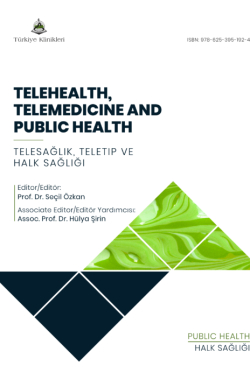Telehealth and Migrant Health
Tufan NAYİRa , Toker ERGÜDERb
aT.C. Ministry of Health General Directorate of Management Services, Ankara, Türkiye
bUniversity of Health Sciences Gülhane Faculty of Medicine, Department of Public Health, Ankara, Türkiye
Nayir T, Ergüder T. Telehealth and migrant health. In: Özkan S, ed. Telehealth, Telemedicine and Public Health. 1st ed. Ankara: Türkiye Klinikleri; 2024. p.52-6.
ABSTRACT
Currently, the use of telehealth applications in the provision of health services is increasing due to developing technological approaches, adaptation of health professionals and societies with technology, and the ease of access to technology. This provides a more accessible and more beneficial health service delivery. However, in many countries, regulations on the use of telehealth services by migrants, refugees or asylum seekers, who are among the groups that may have problems in accessing health services, have not been made. This review is written to provide information about the health problems frequently encountered by migrants and the steps that have been taken and should be taken in countries to enable telehealth applications to reduce these health problems and decrease diseases that can be prevented.
Keywords: Emigrants and immigrants; migrant; refugee; asylum seeker; telemedicine
Kaynak Göster
Referanslar
- Chesnay M. Vulnerable Population: Vulnerable People. Caring for Vulnerable Perspective. Nursing Theory Nursing Theory, Practice, and Research. 2nd ed. Chapter 1: Conseps. Washington: Jones and Bartlett Publishers; 2008. p.3-14.
- Necipoğlu D, Bebiş H, Seviğ EÜ. Dezavantajlı gruplar (göçmen, mülteci, sığınmacı, gey, lezbiyen, mahkumlar...) ve kültürel yaklaşım. Tanrıverdi G, editör. Kültürlerarası Hemşirelik. 1. Baskı. Ankara: Türkiye Klinikleri; 2019. p.68-75
- Khosla N, Washington KW, Shaunfield S, Aslakson R. Communication Challenges and Strategies of U.S.Health Professionals Caring for Seriously Ill South Asian Patients and Their Families Journal Of Palliatıve Medicine. 2017; 20:6-10. [Crossref] [PubMed]
- Fansa M. Kimim Ben? Göçmen, Sığınmacı, Mülteci, Yabancı, Vatansız ve Geçici Koruma: Türkiye'deki Suriyeliler. Antakiyat. 2021;4(2):289-306.
- WHO. Promoting the health of migrants: Report by The Secreteriat. Sixty-ninth World Health Assembly: World Health Organization; 2016
- Beşer A, Tektaş-Kerman K. Göç eden bireylerin öncelikli sağlık sorunları ve sağlık hizmetine ulaşımdaki engeller. Turkiye Klinikleri Public Health Nursing-Special Topics. 2017;3(3):143-8.
- UNHCR. UNHCR Mid-Year Trends 2015: United Nations High Commissioner for Refugees: The UN Refugee Agency; 2015.
- Connor P, Krogstad JM. Key facts about the world's refugees. Pew Research Center report. 2016. [cited: Nov 02, 2023]. Available from: [Link]
- Missinne S, Bracke P. Depressive symptoms among immigrants and ethnic minorities: a population based study in 23 European countries. Social Psychiatry and Psychiatric Epidemiology. 2012;47(1):97-109. [Crossref] [PubMed]
- Bollini P, Pampallona S, Wanner P, Kupelnick B. Pregnancy outcome of migrant women and integration policy: a systematic review of the international literature. Soc Sci Med. 2009;68(3):452-61. [Crossref] [PubMed]
- Aksu H, Sevil Ü. Göç ve Kadın Sağlığı. Maltepe Üniversitesi Hemşirelik Bilim ve Sanatı Dergisi. 2010;2(3):133-8.
- Agudelo-Suárez AA, Gil-González D, VivesCases C, Love JG, Wimpenny P, Ronda Pérez E. A metasynthesis of qualitative studies regarding opinions and perceptions about barriers and determinants of health services' accessibility in economic migrants. BMC Health Services Research. 2012;12(1): 461. [Crossref] [PubMed] [PMC]
- Hacker K, Anies M, Folb BL, Zallman L. Barriers to health care for undocumented immigrants: a literature review. Risk Management and Healthcare Policy. 2015;8:175. [Crossref] [PubMed] [PMC]
- Tuckson RV, Edmunds M, Hodgkins ML. Telehealth. N Engl J Med. 2017; 377(16):1585-1592. [Crossref] [PubMed]
- Adetosoye F, Hinton D, Shenai G,Thayumanavan E. Virtual health for all: Closing the digital divide to expand access. McKinsey & Company; 2023.
- O'Mara B, Monani D, Carey G. Telehealth, COVID-19 and Refugees and Migrants in Australia: Policy and Related Barriers and Opportunities for More Inclusive Health and Technology Systems. Int J Health Policy Manag. 2022; 11(10):2368-72. [Crossref] [PubMed] [PMC]
- Levine S, Gupta R, Alkwatli K, Almoushref A, Cherian S, Jimenez DF, Cordero Baez GN, Hart A, Weinstock C. Telehealth Perceptions Among US Immigrant Patients at an Academic Internal Medicine Practice: Cross-sectional Study. JMIR Hum Factors. 2022;9(3):e36069. [Crossref] [PubMed] [PMC]
- George S, Hamilton A, Baker RS. How Do Low-Income Urban African Americans and Latinos Feel about Telemedicine? A Diffusion of Innovation Analysis. Int J Telemed Appl. 2012;2012:715194. [Crossref] [PubMed] [PMC]
- Sevean P, Dampier S, Spadoni M, Strickland S, Pilatzke S. Patients and families experiences with video telehealth in rural/remote communities in Northern Canada. J Clin Nurs. 2009;18(18):2573-9. [Crossref] [PubMed]
- Spike EA, Smith MM, Harris MF. Access to primary health care services by community-based asylum seekers. Med J Aust. 2011;195(4):188-91. [Crossref] [PubMed]

